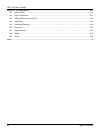
AES-100 User’s Guide
Getting to Know the AES-100 1-1
Chapter 1
Getting to Know the AES-100
This chapter describes the key features, benefits and applications of your AES-100.
The AES-100 is an ADSL (Asymmetrical Digital Subscriber Line) to Ethernet switch. It aggregates traffic from up
to 16 ADSL lines to Ethernet.
ADSL allows the coexistence of broadband data service and conventional voice service over the same telephone
wire. When deployed together with ZyXEL’s ADSL modems, for instance the P642M, and WAN routers, like the
P1400, the combination forms an integrated solution for providing broadband services to multiple tenant units such
as apartments, hotels, offices and campus buildings.
1.1 Features
Two-Slot Chassis
The AES-100 has two slots for the ADSL to Ethernet multiplexer modules. This design provides the flexibility for
you to install as few as a single module for the initial deployment and yet still has room to grow as demand
increases.
8-Port ADSL to Ethernet Multiplexer Modules
Each ADSL to Ethernet multiplexer module aggregates traffic from 8 lines to an Ethernet port.
Integrated Splitters
The integrated splitters eliminate the need to use external splitters to separate voice-band and ADSL signals.
10/100 Mbps Auto-sensing Ethernet Port
This 10/100 Mbps auto-sensing Ethernet port connects the AES-100 to an Ethernet network. With Ethernet as the
backbone, you can create a network that provides ADSL service to hundreds of subscribers.
ADSL Compliance
• Multi-Mode ADSL standard
G.DMT (ITU-T G.992.1)
G.Lite (ITU-T G.992.2)
G.hs (ITU-T G.994.1)
ANSI T1.413 issue 2
•
Rate adaptation support
Bridging
•
IEEE 802.1D transparent bridging
•
Up to 4096 MAC entries address table
•
IGMP snooping for appropriate multicast forwarding.


















